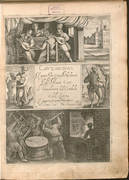Music History's Earliest Engraved Notes – Simone Verovio
Martin Bierwisch
Monday, July 22, 2019

While printed music in the 16th century was primarily produced using type printing, which gave it a typically blurry overall look (except with Ottaviano Petrucci), the printed editions by Simone Verovio are particularly striking because of their handwritten appearance. The engraved printed music is easily recognizable through its characteristic platemark.
The first prints that were published by Verovio (died 1607 in Rome) appeared in 1586. Up to 1608 you can find anthologies and individual editions where he signs his name. Martin van Buyten should also be mentioned in this context, who worked with Verovio and was himself an engraver. In a broadsheet from 1587 titled Essemplare di XIII lingue principalissime, they demonstrate the possibilities of engraved lettering. A variety of alphabets from 14 writing systems are no problem for the engravers and everything is possible including German handwritten Kurrent, Greek, and Hebrew.
It’s not only the writing but also the illustrations that catch the eye. Take the title page of the four-part canzonettas from 1591 (see image). In the top corner where the musicians are playing, one notices that the two music volumes are in oblong format. Interestingly, only Verovio editions in upright format are known.
Those wondering whether it is worthwhile to also look at later editions need look no further than the three-part Canzonette spirituali anthologies. While the three known copies of the 1591 edition preserve only the Bassus and Altus partbooks, the later edition from 1599 also delivers a Superius. Moreover, it is only in the Superius part that the dedicatee can be found, in this case Vincenzo I of Mantua (1562-1612).
Those are just a few small examples of what you can discover. Go exploring with Verovio. Most of the printed editions are digitized. For the collection Lodi della musica (1595|6), even three of the four known copies are digitized.
Today Verovio lends his name to the modern digital engraving library developed by the Swiss RISM office. Even if you don’t know the project, you know what it can do: Verovio is used to display the music incipts in both the RISM online catalog and our internal cataloging program Muscat.
If you want to learn more about Verovio (the person), you can look at the usual encyclopedias as well as a new publication by Auguste Campagne: Simone Verovio - Music printing, intabulations and basso continuo in Rome around 1600. Wiener Veröffentlichungen zur Musikgeschichte, vol. 13 (Vienna: Böhlau Verlag, 2018; cited in RISM as CampagneV 2018).
Image: Title page from CANZONETTE | A quattro Voci, | Composte da diuersi | Ecc.ti Musici. Copy in Bayerische Staatsbibliothek (D-Mbs, 4 Mus.pr. 10), RISM ID no. 993120915.
Share Tweet EmailCatégorie: A la une

